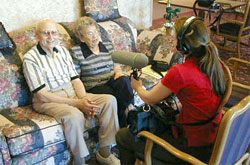Rural Communities in an Era of Fewer Farms
Consolidation, new technologies, innovative business practices—these are some of the ways farmers are adapting to the global economy. But it's not just farmers that are changing, so are rural communities.
Dean Torreson is city manager for Spencer, Iowa, a town of some 11,000. Spencer is in better shape than many nearby farm towns whose main streets have become ghost towns. Folks from those towns are coming here to shop now. But that's not enough to maintain a thriving community.
"Rural America is in decline," Torreson says. "As there are fewer farmers, there's less money flowing into the community."
Farm subsidies are often justified as necessary to prop up rural America. But Karl Stauber of the Northwest Area Foundation says it's a myth that "rural" and "agricultural" are the same. For instance, a majority of jobs counted as agricultural, such as in food processing and production, are in metropolitan areas.
"So I think the notion of helping rural communities to be prosperous is a great political objective," says Torreson, "but doing it through agriculture is missing the mark quite significantly."
Towns like Spencer are taking matters into their own hands and diversifying their economic base. In Spencer, that means catering to an aging population.
The three-story, three-building, red-brick complex that makes up St. Luke's Lutheran Home rests on top of a small rise above Highway 71. The nonprofit offers senior citizens the option of moving into an independent living apartment, an assisted living center, or a nursing home. St. Luke's is one of five elder centers in town.
Mildred Bruns is 85 years old, and her husband Carl is 89. They're waiting for lunch outside the cafeteria in the independent living complex at St. Luke's. They've lived there for seven years. Their home was in Sheldon, about 40 miles away. Carl sold insurance, and Mildred raised a family. Despite summering for years in southern Texas, they retired to Spencer.
 |    |  |
 |
 |
 |
 |  |  |
 |
Mildred and Carl Bruns with Producer Stephanie Curtis. Click to enlarge.
Photo: Chris Farrell |
 |
 |    |  |
Mildred Bruns is 85 years old, and her husband Carl is 89. They're waiting for lunch outside the cafeteria in the independent living complex at St. Luke's. They've lived there for seven years. Their home was in Sheldon, about 40 miles away. Carl sold insurance, and Mildred raised a family. Despite summering for years in southern Texas, they retired to Spencer.
"Our roots are here," says Bruns, "and this is where we should be. ... There is a lot to do .... More than in Sheldon. And we take part in the community theaters, and we have season tickets to that and the concerts. Carl belongs to Kiwanis. I belong to bible study .... We belong to Grace Methodist Church .... In fact the whole town is friendly."
Spencer's elderly population, as well as its townspeople and commuters, shop on Grand Avenue, the town's main street. As in many rural cities, the long main street is lined with classic, small-town, two-story buildings. But in Spencer only two or three stores are vacant.
Bob Rose is head of the local chamber of commerce. "It's quite unique in that we have one of the Midwest's largest collections of art deco architecture in our downtown," Rose says. "And if you look at the buildings you will see the little tiled roof areas, the definite points of difference, the design in the brick work, and the terracotta trim that are all part of the early 20th century arts and crafts, art deco architecture."
Town leaders are lobbying for their main street to be designated a historic site by the National Trust for Historic Preservation—for both recognition and money. Businessmen like Bob Rose also hope a charming downtown will help keep or attract young, tech-savvy workers and entrepreneurs in the new digital economy.
"The best thing we have to offer young people is a quality of life," Rose says, "very low crime rate, very easy to move from one place to another .... We try to provide some of those amenities you find in big cities."
For example, the town's municipal utility invested in a high-tech communications network. And a group of local investors is converting empty second-story rooms above the retail stores on Grand Avenue into city-like lofts that should appeal to a younger generation. "We are almost ready with our first project .... We'll create three apartments, and we'll have to create some of the uniqueness. Brick walls. Open space," says Rose.
But despite all the efforts by community leaders to grow Spencer, the town has managed to gain only 250 people in a decade.

